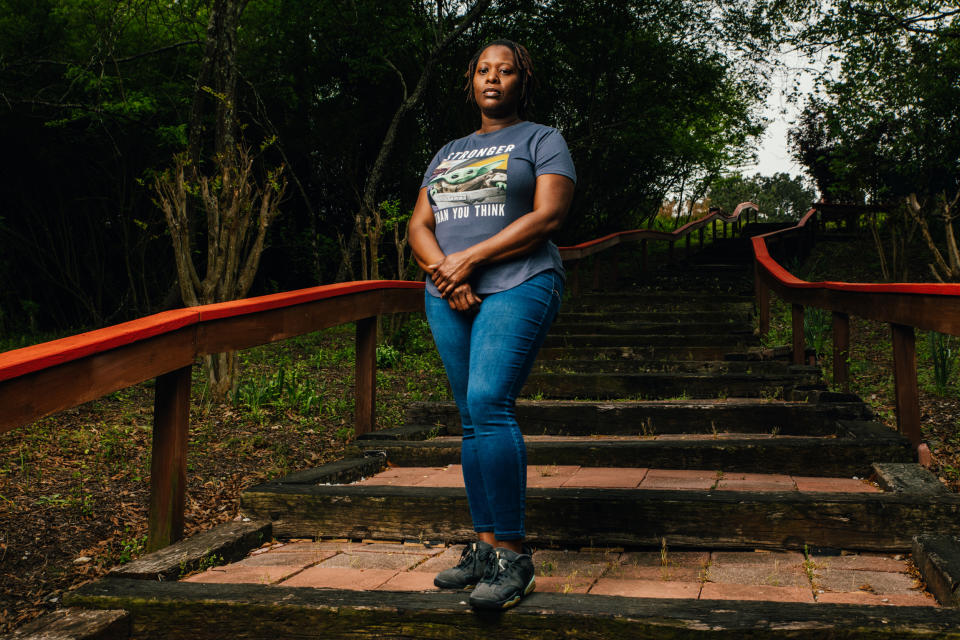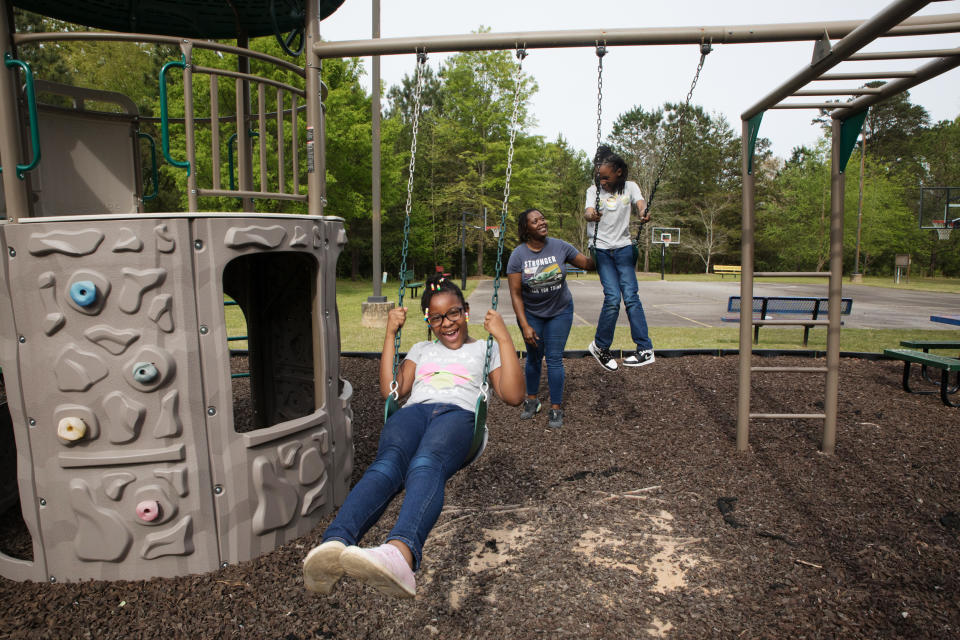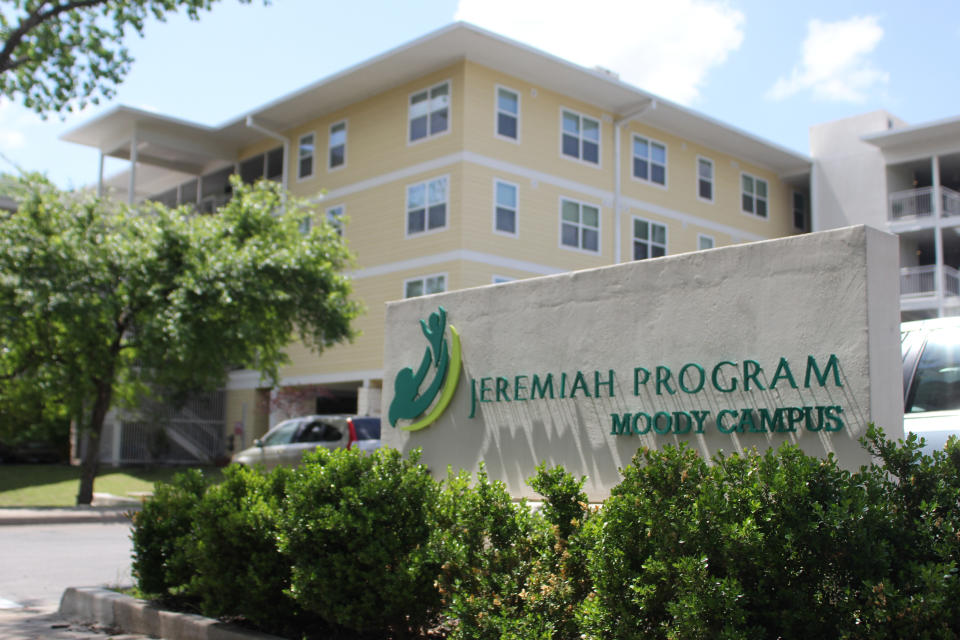Structural, but solvable: These programs could be key to breaking cycle of poverty
This article about two-generation programs was produced by The Hechinger Report, a nonprofit, independent news organization focused on inequality and innovation in education. Sign up for Hechinger’s newsletter.
Last spring, Ciera Pritchett watched her life fall apart.
As the coronavirus pandemic swept the country in March 2020, she first lost her job as a cook and food server at a private school in Savannah, Georgia. Then she was told that her second job, as a transit driver for people with disabilities, would end.
She depleted her savings to pay rent and buy food for herself and her 9-year-old daughter, Genesis. Unemployment insurance helped but fell short of what she needed to pay the bills.
“I was afraid. I was depressed,” Pritchett said. “Honestly, I didn’t know what I was going to do.”
In May, Pritchett and her daughter packed up and moved 270 miles across Georgia to be closer to her son, Isaiah, 10, who lived with his father near Atlanta. They cried together as they said goodbye to Genesis’ favorite teacher on FaceTime. They moved into a bedroom in Pritchett’s best friend’s house, and often confined themselves inside all day as Genesis did online school and they tried to stay out of their hosts’ way.
Pritchett struggled to contribute to utility payments and worried about being a burden. She considered sending her daughter to live with her mother and living in her car.

A major goal of President Joe Biden’s $1.9 trillion coronavirus relief package is to help families like that of Pritchett. The American Rescue Plan, which passed in March, could cut the child poverty rate in half. The expanded child tax credit, which families can receive in monthly payments, provides funds to millions of parents who didn’t qualify previously. The relief package includes other provisions that will help, too, including $39 billion for the nation’s fractured child care system, which should provide more families with child care assistance.
Related: With help slow to come from Washington, a veteran’s family gets by washing cars, skipping meals
But some experts say the government needs to do far more to truly address poverty, including strengthening unemployment insurance, raising the minimum wage, ensuring paid leave for families and establishing universal preschool. There are also broader factors that need to change to disrupt the cycle of poverty, like systemic racism.
“Child poverty in the United States is persistent, it’s structural. But it’s also really solvable,” said Areeba Haider, a research associate for the Poverty to Prosperity Program at the Center for American Progress.
One way to reduce child poverty, experts say, is to support on-the-ground programs that offer comprehensive “two-generation” help, providing services to kids and their parents at the same time. These programs simplify access to assistance for families in crisis while simultaneously addressing the root causes of poverty, including a lack of educational opportunities. They tackle the many intricate issues that, especially when combined, lead to poverty or keep a family in poverty — offering a potential model for what it would take to lift up the millions of struggling American families.
For Pritchett, things started to look up in the early fall when she learned that a local shelter, Gwinnett Children’s Shelter, offered a two-generation support program called Home of Hope and had room for her and Genesis. She had also found a job testing routers and modems for an internet company, and now thanks to Home of Hope she had a free place to live, free meals, access to financial planning and a coach who could help her set and reach independent living goals.
“I feel more relieved now,” she said one afternoon as her daughter played with friends outside their room at Home of Hope. “I feel so much better since we came here. A weight has been lifted off my shoulders.”

A chance to focus on the future
The pandemic has led to a steep increase in child poverty rates, food insecurity rates and unemployment, with Black and Latino families disproportionately experiencing economic hardship. From February to June 2020, the number of children in families with earnings below the poverty level, which is $26,500 for a family of four, rose by nearly 5 million. More than 40 percent of children now live in a household struggling to pay for basic expenses. And as many as 11 million children could be living in homes where they don’t have enough food.
Food pantries and unemployment insurance application systems have crumbled under the sheer volume of demand. Families have struggled to get help for rent and utilities, often hitting a tangle of red tape, and despite a federal moratorium, evictions have continued.
Covid-19 “absolutely ravaged communities,” said MJ Korpela, family services director at Jeremiah Program, a two-generation support program in Austin, Texas, and six other locations nationwide.
Programs such as Jeremiah and Home of Hope aim to offer wide-reaching aid that addresses the causes of poverty, rather than offering piecemeal solutions for single issues. Jeremiah Program, almost entirely funded by donations from individuals and institutions, will offer more than 1,100 moms and children stable housing, mental health support, parenting education and help with higher education classes this year.

Elements of a two-generation approach have been evident in some programs since the 1960s, such as through the federally funded Head Start program, which offers services and resources for parents of children who are enrolled in a Head Start classroom. Two-generation programs became more prominent in the 1980s and the 1990s and have relied mostly on philanthropic funding, although more federal funding has been made available in recent years.
Research shows that two-generation approaches can improve the well-being of mothers and their children, leading to higher education attainment, jobs with livable wages and better academic performance for children. Parents are more likely to enter the workforce and retain stable employment when they have stable child care, something that is often offered by two-generation programs. And when caregivers are able to attain credentials or higher education degrees through two-generation programs, thus finding higher-paying jobs, it can have an impact on their children’s income down the road.
“When families have access to resources, they’re going to be more able to start thinking about what’s the next step, what’s coming next, and be able to focus more on the future,” said Paola Silvestre, director of Family Pathways at United Way for Greater Austin, which runs several programs aimed at supporting low-income parents and their children. “It’s really hard to focus when you’re thinking, ‘I don’t have food in my house, I don’t have a place to live.’”
But the coronavirus pandemic has pushed these small, already-overstretched programs to the limit as they’ve tried to meet the enormous demand of their communities. Many saw an increase in applications from families while at the same time, donations dropped and fundraising events that support these programs were canceled. Some two-generation programs, like Home of Hope, were only able to continue their work because they received federal funding through coronavirus relief packages.
Korpela saw the pandemic as the ultimate test of the Jeremiah Program’s effectiveness: Could it help families withstand a global health crisis and massive recession?
She believes the answer is a resounding “yes.”
Korpela said that in talking to moms in the program, she realized, “Covid hasn’t impacted them too much because they were so supported.” While there was some psychological impact from isolation, and many were also grappling with the nation’s racial reckoning, these families, for the most part, were able to rely on the program to help them meet their basic needs.
“For families in poverty, one thing can catapult a loss of everything,” she said. But Jeremiah Program “kept that full momentum going … and [families] didn’t fall back.”
Sydney Martens, a single mother of a 2-year-old, is working toward finishing her degree in criminal justice. She said that she hasn’t worried about paying for rent or child care because she’s been in the Jeremiah Program in Austin throughout. “Besides us being stuck in the house, we’ve had it pretty easy,” she said.

‘Money is not enough’
At Home of Hope, which considers itself a “next step” toward independence, Pritchett found more than just housing. She doesn’t have to worry about meals or snacks. She and her daughter received a free room and a private bathroom. Each resident is assigned a case manager to meet with weekly. Mothers have customized “life plans” to target their future goals and address emotional, physical and educational needs.

The goal is to help the family get on a strong footing so there’s less chance they will backslide once they leave. “We’re teaching moms to be independent,” said Maureen Kornowa, executive director of Home of Hope. “We’re going to teach you how to navigate life.” (Home of Hope and Jeremiah Program serve only mothers and children; some other two-generation programs work with fathers as well.)
With the help of her case manager, Pritchett is working on saving her money and budgeting so she will have a down payment on a house or a security deposit and rent for an apartment when she moves out by October; families can stay for up to a year. Her daughter attends frequent activities and programs on the campus, which Kornowa said are meant to provide children with a safe, nurturing environment where they can focus on being kids.
“The whole idea, the bottom line, is it’s a multigenerational approach to ending the cycle of homelessness,” Kornowa said. “You keep that family unit together and teach mom to fish.”
Without the help of the shelter, Pritchett could have applied for decades-old federally funded programs that provide piecemeal support for families, like the Temporary Assistance for Needy Families (TANF), unemployment insurance and food stamps. While many of these programs are proven to help families and lead to better academic achievement for children, they are administered through states and often fall short of reaching all families in need. Many have lengthy waitlists or cumbersome application processes.
And forcing families with young children to wait for help can have a disastrous impact. Research shows poverty can cause trauma that affects the brain during the first few years of life when brain development is most rapid. This can affect emotional processing, judgment and academic achievement as children age.
At the Jeremiah Program in Austin, this research is why the focus is on helping mothers and children before “poverty has taken its toll on development,” Korpela said.
Mothers receive coaching while working on their educational and career goals. They get life skills and empowerment training, covering topics such as financial literacy and parenting, and explanations of the inherent racism in systems, including those that contribute to poverty — all of which, research shows, can help people develop skills and mindsets that can disrupt poverty.
One program piloted by the United Way for Greater Austin gives parents free tuition and a stipend to train for a skilled trade, such as plumbing or a health care job, like EKG technician. Parents receive a free laptop, transportation assistance and career coaching, and their kids are enrolled in high-quality child care.
“Money is not enough,” said Chastity Lord, president and CEO of Jeremiah Program. “People don’t live single-issue lives, because they don’t have a single-issue struggle.”
Intertwined challenges
Leaders of many of these programs say they see the success of their approach in how well families do after leaving. In a recent Jeremiah Program alumni survey, mothers said they had seen a 68 percent increase in their earnings, on average, since starting the program. Nearly 90 percent of children in the program’s child development centers perform above developmental benchmarks. The average annual income of graduates from the past five years is more than $47,000, slightly higher than the annual median income for families led by a single mother.
At Home of Hope, 82 percent of mothers and children transition into stable housing. Kornowa said the rate of mothers who become homeless after leaving the program is low due to the program’s stringent expectations of moms, which include abiding by a curfew, finding employment, attending parenting programs and saving money. At the United Way for Greater Austin, almost 30 percent of parents or caregivers earned a high school diploma or equivalent credential while enrolled in one of the organization’s two-generation programs.
But these initiatives can be costly to run and expand. Home of Hope, funded by private donations and fundraising events, spends more than $4,800 a month per family in its program. Jeremiah Program had more than $11 million in operating expenses in 2019, and the nonprofit will need an estimated $50.5 million to pay for a planned expansion that would help four times as many mothers and children over the next five years.
Related: Homeless students set adrift by school closures face crisis after crisis
Offering high-quality child care alone is expensive. Programs often cobble together funds from private foundations, fundraising events and the government. And programs must have flexible and highly trained staff members who can attend to families’ needs for support. That means hiring professionals who can offer everything from mental health support to parenting education classes. Many programs also rely on external partnerships, such as with local community colleges.
Advocates say the challenges are worth it. When families have these types of extensive support systems in place, it can help them weather storms that might otherwise be disastrous.
“Addressing just one barrier, when there are so many that are so intertwined, is just not a holistic approach and it’s just not a realistic approach,” Korpela said. “You’re taking some of that burden off families to try to be piecing it together on their own.”

With the help of Home of Hope, Pritchett has started to plan for a more secure future.
Since she moved in, she has saved 40 percent of every paycheck for future rent payments and found a new job at a warehouse that pays more than she was making testing routers. She’s had more visits with her son. Her daughter has flourished, too. She was recently accepted into her school district’s gifted program and, when asked, talks excitedly about the many activities available for kids at Home of Hope.
But one of the biggest differences has been emotional, Pritchett said. She is less anxious and more patient, especially with her children. “I don’t have a lot of outside stressors anymore because I’m somewhere stable,” Pritchett said. “I’m just really happy that we found this place. It’s a lot less stress on me.”

